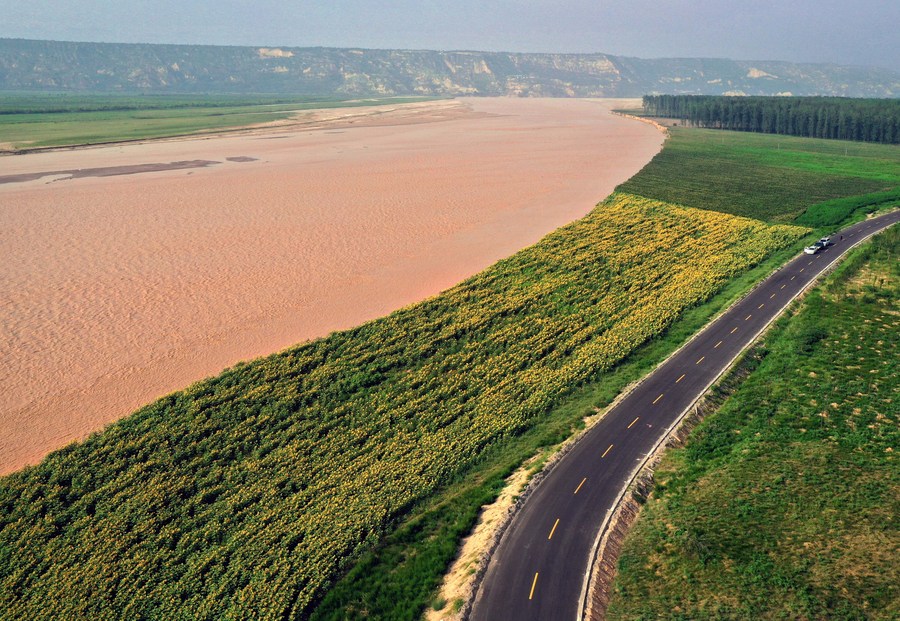
Aerial photo taken on Aug. 10, 2022 shows a section of the ecological corridor along the Yellow River in Sanmenxia City, central China's Henan Province. (PHOTO:?XINHUA)
By?WANG?Xiaoxia
The Yellow River is revered as the mother river of Chinese people, as it carries the ancient Chinese culture and invigorates social economic development along its banks. Most notably, the river's drainage areas produce one-third of the country's crop yields.
However, there are frequent devastating floods and course changes caused by the continual elevation of the river bed, as well as serious droughts due to over-exploitation of its water.
Since ancient times, Chinese people have fought against the mighty Yellow River, gradually learning to protect it and coexist in harmony.
Longterm fight
The adjective "yellow" literally describes the color of the muddy water in the lower course of the river, which arises from soil (loess) being carried downstream mainly from the Loess Plateau in the middle of its course. The river bed even rises above the level of its surrounding fields in some regions.
According to historical records, in more than 2,540 years before 1949, about 1,500 floods occurred and the river course had changed 26 times. Now it empties into the Bohai Sea in Dongying, Shandong province.
Meanwhile, the unlimited river water usage in irrigation led to severe drought. The river dried up halfway to the sea, leading to degradation of wetlands and erosion of coastal lines.
According to elderly residents born in early 20th century, in the past the youth were organized to remove the loess from the river bed and use it to shore up the river bank before the rainy seasons.
Traditional flood control techniques made use of levees, revetments to absorb the energy of the water, overflow basins, drainage canals and polders. But this was not a permanent solution, as people had to repeat the hard work every year.
After the founding of the People's Republic of China, the management of the Yellow River was upgraded from flood control at the lower reaches, to comprehensive control of the whole river basin and branch basins.
Comprehensive treatment
Jiuyuan valley in Suide, a county under the city of Yulin in Northwest China's Shaanxi province, is one of the thousands of valleys on the Loess Plateau. Local people's 70-year effort may help explore solutions to soil and water conservation.
In 1952, the Yellow River Conservancy Commission (YRCC) set up an experiment station for the conservation of water and soil in Suide. One year later, with the support of scientists and engineers, a dam was built to hold back loess and release cleaner water away, helping layers of loess slowly transform into fertile land.
This is a successful practice, which not only relieves soil erosion, but also helps increase grain output, said Dang Weiqin, chief engineer of the Suide experiment station. Therefore, a number of dams were built in the region, until heavy rain destroyed many of them.
Thanks to a more complete dam system built after the 1950s, large dams protect not only the bank of river, but also small ones from floods. Meanwhile, people planted trees and grass to better conserve soils and relieve pressures on infrastructure projects.
In the past decade, the integrated protection of ecological environment including mountains, rivers, forests, farmlands, lakes and grasslands, has resulted in progress in water and soil conservation along the whole river basin.
Innovative coordination
To solve the water shortage problems, the YRCC carried out an overall plan for water usage every year since 1999, setting upper limits of volume for each province the river runs through. Technologies have also been applied to ensure more efficient utilization of water.
According to Zhang Li, who works at the Lijin hydrometric station near the river mouth, no water flowed into the sea for 226 days around 1997. After the implementation of an overall plan, the river never dried up for the following 23 years in a row.
The Yellow River runs through seven provinces and two autonomous regions. To deal with water pollution, collaboration between neighboring provinces is critical, said Wang Tao, researcher at Northwest Institute of Eco-Environment and Resources, Chinese Academy of Sciences.
Wang stressed the inter-regional ecological compensation mechanism, which means if the quality of water running down from the upper stream improves, the downstream province should pay for the upper's effort; if not, the upstream province should compensate the downstream region.
In 2021, Shandong signed an agreement with its upstream neighbor Henan. One year later, benefitting from cleaner water, Shandong fulfilled the delivery of 126 million RMB of ecological compensation.
The trio will conduct a series of experiments in fields such as life science, fluid physics, combustion science and materials science. Notably, this is the first time that fruit flies have been taken on a Chinese space mission as experimental subjects. What made scientists choose fruit flies? What experiment will they undergo?
